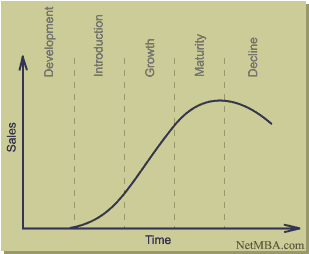Marketing > Product Life Cycle
The Product Life Cycle
A product's life cycle (PLC) can be divided into several stages characterized by the revenue generated by the product. If a curve is drawn showing product revenue over time, it may take one of many different shapes, an example of which is shown below:
Product Life Cycle Curve

The life cycle concept may apply to a brand or to a category of product. Its duration may be as short as a few months for a fad item or a century or more for product categories such as the gasoline-powered automobile.
Product development is the incubation stage of the product life cycle. There are no sales and the firm prepares to introduce the product. As the product progresses through its life cycle, changes in the marketing mix usually are required in order to adjust to the evolving challenges and opportunities.
Introduction Stage
When the product is introduced, sales will be low until customers become aware of the product and its benefits. Some firms may announce their product before it is introduced, but such announcements also alert competitors and remove the element of surprise. Advertising costs typically are high during this stage in order to rapidly increase customer awareness of the product and to target the early adopters. During the introductory stage the firm is likely to incur additional costs associated with the initial distribution of the product. These higher costs coupled with a low sales volume usually make the introduction stage a period of negative profits.
During the introduction stage, the primary goal is to establish a market and build primary demand for the product class. The following are some of the marketing mix implications of the introduction stage:
Product - one or few products, relatively undifferentiated
Price - Generally high, assuming a skim pricing strategy for a high profit margin as the early adopters buy the product and the firm seeks to recoup development costs quickly. In some cases a penetration pricing strategy is used and introductory prices are set low to gain market share rapidly.
Distribution - Distribution is selective and scattered as the firm commences implementation of the distribution plan.
Promotion - Promotion is aimed at building brand awareness. Samples or trial incentives may be directed toward early adopters. The introductory promotion also is intended to convince potential resellers to carry the product.
Growth Stage
The growth stage is a period of rapid revenue growth. Sales increase as more customers become aware of the product and its benefits and additional market segments are targeted. Once the product has been proven a success and customers begin asking for it, sales will increase further as more retailers become interested in carrying it. The marketing team may expand the distribution at this point. When competitors enter the market, often during the later part of the growth stage, there may be price competition and/or increased promotional costs in order to convince consumers that the firm's product is better than that of the competition.
During the growth stage, the goal is to gain consumer preference and increase sales. The marketing mix may be modified as follows:
Product - New product features and packaging options; improvement of product quality.
Price - Maintained at a high level if demand is high, or reduced to capture additional customers.
Distribution - Distribution becomes more intensive. Trade discounts are minimal if resellers show a strong interest in the product.
Promotion - Increased advertising to build brand preference.
Maturity Stage
The maturity stage is the most profitable. While sales continue to increase into this stage, they do so at a slower pace. Because brand awareness is strong, advertising expenditures will be reduced. Competition may result in decreased market share and/or prices. The competing products may be very similar at this point, increasing the difficulty of differentiating the product. The firm places effort into encouraging competitors' customers to switch, increasing usage per customer, and converting non-users into customers. Sales promotions may be offered to encourage retailers to give the product more shelf space over competing products.
During the maturity stage, the primary goal is to maintain market share and extend the product life cycle. Marketing mix decisions may include:
Product - Modifications are made and features are added in order to differentiate the product from competing products that may have been introduced.
Price - Possible price reductions in response to competition while avoiding a price war.
Distribution - New distribution channels and incentives to resellers in order to avoid losing shelf space.
Promotion - Emphasis on differentiation and building of brand loyalty. Incentives to get competitors' customers to switch.
Decline Stage
Eventually sales begin to decline as the market becomes saturated, the product becomes technologically obsolete, or customer tastes change. If the product has developed brand loyalty, the profitability may be maintained longer. Unit costs may increase with the declining production volumes and eventually no more profit can be made.
During the decline phase, the firm generally has three options:
Maintain the product in hopes that competitors will exit. Reduce costs and find new uses for the product.
Harvest it, reducing marketing support and coasting along until no more profit can be made.
Discontinue the product when no more profit can be made or there is a successor product.
The marketing mix may be modified as follows:
Product - The number of products in the product line may be reduced. Rejuvenate surviving products to make them look new again.
Price - Prices may be lowered to liquidate inventory of discontinued products. Prices may be maintained for continued products serving a niche market.
Distribution - Distribution becomes more selective. Channels that no longer are profitable are phased out.
Promotion - Expenditures are lower and aimed at reinforcing the brand image for continued products.
Limitations of the Product Life Cycle Concept
The term "life cycle" implies a well-defined life cycle as observed in living organisms, but products do not have such a predictable life and the specific life cycle curves followed by different products vary substantially. Consequently, the life cycle concept is not well-suited for the forecasting of product sales. Furthermore, critics have argued that the product life cycle may become self-fulfilling. For example, if sales peak and then decline, managers may conclude that the product is in the decline phase and therefore cut the advertising budget, thus precipitating a further decline.
Nonetheless, the product life cycle concept helps marketing managers to plan alternate marketing strategies to address the challenges that their products are likely to face. It also is useful for monitoring sales results over time and comparing them to those of products having a similar life cycle.
Marketing > Product Lifecycle


